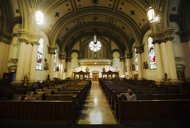Iran delayed promised long-range missile tests in the Gulf on Saturday and Tehran signaled it was ready for fresh talks on its disputed nuclear program.
"One of the messages was that you mess with Iran, then you stand to suffer from economic havoc," he said. "Iranians have always used this method of carrot and stick ... first they used the stick of closing Hormuz and now the carrot is its willingness for talks."
Reports on Iran threatening to close the strait of Hormuz by Iran were enough to send tremors through oil markets and spike the price of oil.
Iran's state media initially reported early on Saturday that long-range missiles had been launched during naval exercises, a move that may irk the West concerned over threats by Tehran to close off a vital oil shipping route in the Gulf.
But Deputy Navy Commander Mahmoud Mousavi later went on the English language Press TV channel to deny the missiles had in fact been fired.
"The exercise of launching missiles will be carried out in the coming days," he said.Ten days of Iranian naval drills have coincided with increased tension over Tehran's nuclear program with Washington and its allies. The European Union said it was considering a ban - already in place in the United States - on imports from the major oil producer.
Analysts say the conflicting reports on the missile test aimed to remind the West of the unforeseen consequences it risked if it ratcheted up pressure on Iran over its nuclear work, which the West says is aimed at building nuclear bombs. Tehran denies this.
"The location and the timing of the drill were very shrewd ... then came reports on launching missiles that can target America's bases in the region and Israel," said analyst Hamid Farahvashian."One of the messages was that you mess with Iran, then you stand to suffer from economic havoc," he said. "Iranians have always used this method of carrot and stick ... first they used the stick of closing Hormuz and now the carrot is its willingness for talks."
An EU spokesman said EU foreign policy chief Catherine Ashton wrote to Iran's nuclear negotiator Saeed Jalili in October and had not yet had a response. But the European Union was open to meaningful talks with Tehran provided there were no preconditions.
"We continue to pursue our twin-track approach and are open for meaningful discussions on confidence-building measures, without preconditions from the Iranian side," EU foreign policy spokesman, Michael Mann, said in an email.Tehran threatened on Tuesday to stop the flow of oil through the Strait of Hormuz if it became the target of an oil embargo over its nuclear ambitions, a move that could trigger military conflict with countries dependent on Gulf oil.
Iranian Oil Minister Rostam Qasemi said imposing sanctions on Iran's oil exports would lead to a leap in prices.
"Undoubtedly the price of crude will increase dramatically if sanctions are imposed on our oil ... It will reach at least over $200 per barrel," the Aseman weekly quoted Qasemi on Saturday as saying.Reports on Iran threatening to close the strait of Hormuz by Iran were enough to send tremors through oil markets and spike the price of oil.
"BERMUDA STRAIT"
Iran's show of military might in the Gulf was reflected in the scale of the exercises, which Iranian media said were greater than previous war games. However, Iran test-fired its surface-to-surface Shahab-3 missile during 2009 exercises. It is thought to be capable of striking Israel and U.S. bases in the Middle East.
Washington has expressed concern about Tehran's missiles, which include the Shahab-3 strategic intermediate range ballistic missile with a range of up to 1,000 km (625 miles), the Ghadr-1 with an estimated 1,600 km range and a Shahab-3 variant known as Sajjil-2 with a range of up to 2,400 km.
Iranian media have given a massive coverage to the drill, with state television broadcasting live in an apparent attempt to strike a patriotic chord among ordinary Iranians concerned about a military strike.
The United States and Israel have not ruled out a military option if diplomacy fails to resolve Iran's nuclear dispute."I have already witnessed a war with Iraq in 1980s ... I can hear the drum beating of the war. A misfired bullet can spark a serious war," said merchant Mohsen Sanaie, 62, while glancing over newspapers headlines at a central Tehran newsstand.
He warily pointed at the headline of the Sharq newspaper "Power rally in the Strait of Hormuz," and the Vatan-e Emruz daily's "The Bermuda Strait of Hormuz" headline, a reference to the(...)More.





 12/31/2011 05:28:00 AM
12/31/2011 05:28:00 AM
 live news
live news


































